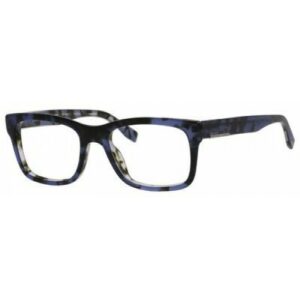How Thin Can High-Index Lenses Get?
High index lenses are the thinnest solution for eyeglasses that has ever been achieved and they just keep getting thinner. For those that keep up with the lens crafting industry, either as professionals or interested glasses-wearing individuals, it has become apparent that the available index for lenses will continue to rise. In the last decade, we have seen an outstanding increase from 1.67 to 1.74, creating an astoundingly thin lens option even for people with strong prescriptions. However, for the average consumer, the connection between the index and a slim lens profile are baffling. How do you know the difference between a 1.67 and a 1.74 and what, really, is the difference in width? They want to know which frames the thinner high-index lenses can support and what the overall effect will be on their appearance and vision. How thin can high-index lenses get? Let’s find out.
What Does the Index Mean?
When talking about high index lenses, the index in question is one of refraction. It can be referred to either as the ‘index of refraction’ or the ‘refractive index’ and represents the speed that a beam of light can pass through a material. To be specific, it refers to the difference between how fast light travels through air versus how quickly it travels through the material. To understand what effect this has on eyeglasses, consider how a straw looks in a glass of water. It doesn’t appear to be in exactly the same place before and after breaking the surface of the liquid. What you’re seeing is an effect of the water, which can also be witnessed when a sunbeam hits a swimming pool. The light bends because it’s speed changes and it travels at a slightly different angle from the change.
What Does the Index Do, Exactly?
Bending light is exactly what the lens of your glasses do. As the image reaches your lens, it bends it to make it larger, smaller, or differently focused in order to compensate for the way your eye sees. Most glass and standard plastic lenses have an index of 1.50, which requires a certain thickness to achieve the right amount of light-bending for your eyes. Higher index materials tend to be denser, bending the light more efficiently at a tighter angle. This means that lenses made this way need less material for the same amount of light-bending, and thinner lenses become a growing possibility. Once this was discovered, all lens crafters needed to do was to try out and craft new materials to see what does and does not make a good high-index Lens.
The Polycarbonate Plastic Lens
Once eyeglasses became something available to the general populace, everyone noticed how heavy glass lenses are. Most modern consumers have never experienced the sheer amount of nose-weight that was once carried by our myopic ancestors because plastic lenses have become vastly superior, but they didn’t start that way. The search for the plastic solution began in the late 1940s when acrylic was tried as a new lightweight material but it was too brittle, easy to scratch, and prone to discoloration. The second solid push for plastic occurred in 1962 with the invention of the ‘conventional’ plastic lens. Sturdier and more scratch resistant than acrylic and lighter than glass, they were still about the same index and unattractive thickness.
In 1972, the FDA mandated that all lens materials have a minimum shatter-resistance as a matter of public safety. In an effort to conform to this, lens crafter began looking for a stronger plastic solution. In 1983 they invented the polycarbonate lens which was crafted for it’s near bulletproof durability. However, in the process of making a sturdier, denser, lens, they also achieved a higher refractive index of 1.59. Upon testing, it was discovered that lenses made of polycarbonate could serve the same prescription at a much thinner width than the standard materials. For any particular prescription 1.59 lenses will be 20% thinner than glass or conventional plastic.
The Steady Pace of Improvement 
Four years later in 1987, the Optima company completed and launched a new lens material known as HYPERINDEX which improved on the polycarbonate design, adding another hundredth of a refractive index point and creating the new ‘thinnest’ lens. While this may sound minuscule, the effect on lens width is still significantly notable. Where 1.59 polycarbonate lenses are 20% thinner than standard materials, the tiny increase to 1.60 brings the new width down to 25%.
Six years later in 1992, Optima took the stage again to introduce a much more impressive index improvement from 1.60 to 1.66, going above and beyond current industry standards to create a jump similar to the original high-index innovation. Soon, other companies were back in the swing of inventing better lens materials and the standard was quickly raised further to 1.67. At this level, your lenses will be a full 30% thinner than glass or conventional plastic.
Around Y2K, Mitsui Chemical Co released another astounding innovation in thin lenses with a material that offers an index of 1.74 without sacrificing clarity or durability. Because the creation of high-index lenses requires careful layering of incredibly dense plastic, it should be no surprise that a chemical company would bring us this latest change and we can hope to see similar in the future. For those that choose to have their prescription made in 1.74 high-index plastic, your lenses will be so thin they will practically disappear into the frames, even for extreme near or far sightedness. Compared to standard lens materials, 1.74 lenses are 34% thinner.
Choosing the Right Index For You
Unlike other forms of technological development, lower indexes have not been discarded entirely in favor of the highest option. This is because there is a wide scale of need for high-index and expense for the advanced lens materials. Lower intensity prescriptions don’t need the highest indexes because there is not much width to reduce. When ordering your lenses, it’s important to keep in mind the combination of the index you need and the material within your budget. Most vendors will offer you conventional plastic lenses which are clear, lightweight, and perfectly functional. These are the width you are used to. Here is a summary of your high-index options:
- 1.59 – 20% width – Polycarbonate lenses are the most common lens upgrade, often chosen by parents for their children to take advantage of the increased durability. They are great for all prescriptions while still offering a slimmer profile.
- 1.60 – 25% width – ‘Super Thin’ lenses are more expensive than their polycarbonate counterparts and are the first index with a prescription recommendation. Most ophthalmologists recommend that you don’t need anything higher than a 1.59 if your prescription is lower than +/-4.0 or your CYL correction is lower than +/-2.25.
- 1.67 – 30% width – The second thinnest index offered is recommended only for stronger prescriptions above the range of +/-1.7 or your CYL correction is above +/-3.25. At this level of thinning, lesser prescriptions would become too thin to manage and offer you very little benefit.
- 1.74 – 35% width – If your prescription is truly extreme, you can gain significant benefit from the highest index available. These sliver-thin lenses make an overwhelming difference in visual clarity and eliminates the appearance distortion caused by thick lenses but are notably more expensive than lower index options.

It’s been nearly eight years since the 1.74 innovation, but given the length of previous intervals in the high-index development cycles, we could be seeing the next highest index any day now. The current options already help everyone from the mildly myopic to the nearly blind gain clear, corrected vision at almost invisible lens widths. We may soon find that the next iteration of high-index lenses resembles something closer to a rigid plastic film than what we’ve come to recognize as a ‘lens’. So how thin can high-index lenses get? They’re already at 35% thinner than glass and the future is looking bright.


Leave a Reply
You must be logged in to post a comment.